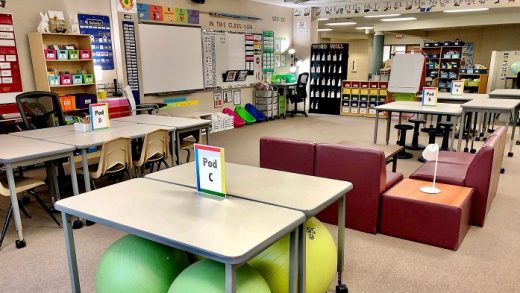Learning Made Easy: The Role of Teaching Aids in Modern Education
In this day and age, children have less and less attention span. Students taught traditionally may lose interest or not understand the topic or the subject. Creatively teaching students is crucial to keeping their focus and attention on any topic.
Interactive learning gets students actively involved in the learning journey, encouraging exploration, questioning, and the practical application of knowledge, resulting in a more profound comprehension. This is where teaching aids play a crucial role, serving as valuable tools to address different learning styles through the use of diverse elements such as graphs, models, visuals, and more.
Contents
What Are Teaching Aids?

In a nutshell, they help students understand topics better and retain information longer. Using a fun and engaging teachers’ teaching aid can help you make learning enjoyable and easy to grasp for everyone. Think of them as friendly companions that visually showcase information, incorporate sounds, or even allow us to touch and interact with objects. For instance, when learning about animals, a teacher might use a vibrant poster with pictures, helping us visualise how they look, their names, and where they live – it’s a teaching aid at work, making information more accessible and memorable.
Types of Teaching Aids
Teacher aids come in various forms, each playing a unique role in enhancing the learning experience for students. These indispensable tools, often likened to magic wands, add a touch of excitement and accessibility to the educational journey.
Visual Aids
Visual aids are among the most popular teaching companions. Colorful charts, diagrams, and photographs serve as visual anchors, helping students grasp complex concepts more easily. Like navigating an adventure with a treasure map, visual aids provide a clear path to understanding.
Audio Aids
These options undoubtedly contribute to the vibrant symphony of learning. From music to engaging recordings, they create an immersive atmosphere, making the educational experience akin to the uplifting effect of a favourite song on one’s mood. They normally consist of audio recordings that students can listen to at their own pace, giving them the freedom and control over their learning process.
Traditional Resources
Traditional tools for teaching, like chalkboards and whiteboards, textbooks, flashcards, maps, and posters, bring classroom learning to life. These timeless tools help teachers explain concepts visually, offer hands-on experiences with models and props, and make subjects like geography and science more tangible.
Educational games and art supplies add an element of fun to lessons, while reference books and graphs provide additional context and visual representation. Despite the digital age, these classic teaching aids play a crucial role, blending simplicity and effectiveness to create an engaging and well-rounded learning experience for students.
Tactile Aids
Tactile aids bring a hands-on dimension to learning. Models, tangible objects, and interactive materials allow students to touch and feel, turning abstract concepts into tangible experiences. This tactile engagement ignites curiosity and excitement, making learning more memorable.
Considered collectively, these teacher aids are not just tools. They are the dynamic elements that transform the classroom into an interactive and engaging space. Whether through visuals, sounds, or tangible experiences, each type of aid contributes to a holistic and enjoyable learning environment, where understanding and retention flourish.
Importance of Using Teacher Aid Supplies

Classroom teaching aids hold immense significance in the educational landscape, acting as catalysts for effective learning and comprehension. Their importance can be summarised across many aspects:
Enhanced Understanding
Educational aids promote a deeper understanding of concepts by presenting information in diverse formats. Visual aids, for example, help students visualise abstract ideas, making complex topics more accessible. Students have varied learning preferences and styles. A well-structured teachers’ teaching aid caters to these differences by providing a range of sensory experiences and accommodating visual, auditory, and tactile learners.
Increased Engagement
The use of teaching aids makes learning more engaging and interactive. Students will likely be attentive and participate when lessons incorporate visual elements, multimedia, or hands-on activities. The use of these helpers encourages active participation in the learning process. Students are more likely to ask questions, seek clarification, and contribute to discussions when aided by visual or interactive elements.
Improved Retention
Information reinforced through teachers’ teaching aids tends to be better retained. Visual aids and interactive materials create memorable experiences, aiding students in recalling and applying knowledge. Even audio options, such as music and recordings, help students retain information through their catchy tunes or relatable content. These learning tools also help create connections between concepts, making it easier for students to remember and apply what they have learned.
Clarity and Illustration
Educational aids clarify complex concepts by providing visual illustrations or practical demonstrations. This clarity is particularly beneficial in subjects where abstract ideas can be challenging to grasp through verbal explanations alone. In a science class, for example, students can better understand the inner workings of a cell by viewing a diagram or through hands-on activities. Similarly, math concepts become more tangible when demonstrated using manipulatives like blocks or counters.
Efficient Time Management
Teaching aids can streamline learning, helping teachers convey information more efficiently. Visual aids, for instance, can bring complex information in a concise and accessible manner. These resources enable educators to enhance their effectiveness. Providing additional tools and methods, aids support teachers in delivering engaging lessons and catering to the diverse needs of their students.
Fostering Creativity and Critical Thinking
Many educational instruments encourage creativity and critical thinking. Interactive activities, experiments, or discussions sparked by teaching tools promote understanding and independent thought. They play a role in promoting an all-encompassing educational environment. They can be adapted to accommodate diverse needs, including students with different abilities, learning styles, or language proficiency.
To Sum Up
In conclusion, these teaching methods emerge as indispensable architects of a positive and effective learning environment. Serving as dynamic companions in the educational journey, they bring concepts to life, enhance understanding, and cater to the diverse needs of students. By promoting engagement, interactive learning, and clarity, they support teachers in delivering impactful lessons and empower students to actively participate and thrive. They are the key contributors to a vibrant, inclusive, and memorable educational experience.
Recognising and appreciating the multifaceted contributions of these educational helpers is not just an acknowledgement of their efforts but a strategic investment in the success of both educators and learners. Teachers’ teaching aids are one of the many essentials every classroom must have to have a fun and educational experience. In the symphony of education, teaching resources are the harmonious notes that elevate the learning experience to new heights.

















